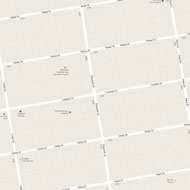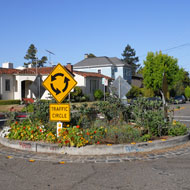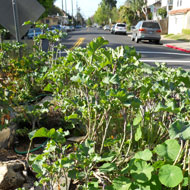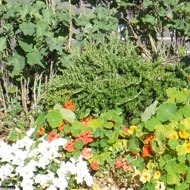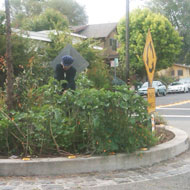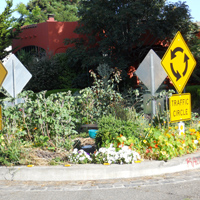
Background
The traffic circle at the intersection of two local streets in the Southside neighborhood of Berkeley, Carleton Street and Ellsworth Street, not only calms traffic but grows edible plants. Both Carleton Street (60-foot right-of-way with a 33-foot wide travelled roadway) and Ellsworth Street (60-foot right-of-way with a 38-foot wide travelled roadway) are two-way residential streets with curbside parking lanes. The traffic circle is lushly planted, even though there is a 24-inch sanitary sewer cover in the middle of the circle.
In the circle, edible plants and flowers are growing, such as kale and lavender. Considering that each traffic circle costs between $8,000 and $10,000 (including the cost of digging the hole, building the curb and raising the sewer catch basin), utilizing the multi-use garden on the circle is beneficial for residents and the city (Jones 2006).
There is high demand for traffic circles from neighbors in Berkeley, despite the fact that neighbors are responsible for planting and maintenance. Local residents living immediately around the circle regularly maintain the traffic circle. This includes weeding, pruning, and watering the plants. The plants are manually watered either by hand or brought through a pipe from an adjoining nearby house. While maintained by a few, all residents are welcome to use the fresh produce grown in the circle.Lessons Learned
Potential Benefits:
- Brings the community together.
- Slows the traffic and strengthens the pedestrian-friendly character of the neighborhood.
- Enhances the visual attraction of the neighborhoods.
- Utilizes an underused space to grow edible plants and flowers.
Potential Issues:
- Damage by cars: Cars may damage the traffic circle gardens by running over the curb.
- Vegetation height: Tall plantings may obstruct cyclists’ and motorists’ views.
- Vandalism: Plants may be harvested by others or vandalized (Jones 2006).
- Maintenance: The edible landscape is currently very well maintained by immediate neighbors who are long terms residents of the neighborhood. However, other traffic circles in less well established neighborhoods may need to explore long term maintenance plans.
- Lack of guidance: The City of Berkeley lacks manuals or directions for planting or maintaining edible landscaping in the traffic circles.
Sources
Jones,Carolyn, 2006. “ Policy Would Codify Traffic Circle Allocations”
Chronicle Staff Writer (http://articles.sfgate.com/2006-11-28/bay-area/17320977_1_slow-traffic-circles-intersections)
Photo Sources
MIG, Inc.

